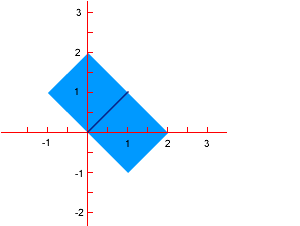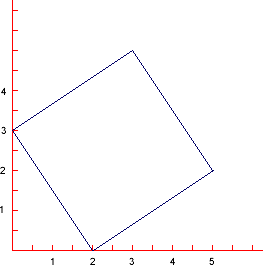Something in common
A square of area 3 square units cannot be drawn on a 2D grid so that each of its vertices have integer coordinates, but can it be drawn on a 3D grid? Investigate squares that can be drawn.
Problem
For this question you can only draw lines between points on the grid with integer coordinates, such as (6,-8,-2) or (3,7,0). You cannot draw lines between points that do not have integer coordinates e.g. (2.5,1,8) .
It is possible to draw a square of area 2 sq units on a coordinate grid so that two adjacent vertices are at the points (0,0) and (1,1) - see diagram below. In fact there are two such squares with sides $ \surd 2$ and area 2 square units - as shown.
Image

The Tilted Squares problem also investigates other squares you can draw by tilting the first side by different amounts. Here is a square with side: $ \surd 13$ and area 13 sq units.
Image

It is not possible to draw a square of area 3 sq. units on the grid. Try some squares for yourself and then explain why.
But is it possible to draw a square of area 3 sq. units in a 3D grid? First, you need to be able to make a side of length $ \surd 3 $. The line joining (0,0,0) to (1,1,1) has a length of $\surd 3$. How do I know?
Then you need three more sides all the same length that meet at the vertices and are at right angles to each adjacent side.
How many squares of area 3 square units can you find with this side in common, and what are the coordinates of their other vertices?
Getting Started
You might also like to look at the problem called "Tilted Squares" published in Sept04.
Some cubes or a construction set might help you to visualise a 3D grid.
How many points are there that are $ \surd 3$ units from (0,0,0)?
Student Solutions
The first part was well explained by Shaun from Nottingham High School as follows:
It is not possible to construct a square of 3 sq. units on a 2-D grid using only integers, because according to Pythagoras the side length must be constructed from the square root of the sum of the squares of two integers.
If the side of the square was tilted and went $x$ along and $y$ up we would need to find $x$ and $y$ so that $ x^2 + y^2 =3$
Yet there are no perfect squares which add up to three, hence this is not possible.
Progressing from here to look for a
square with an area of 3 in a 3D grid could be tackled using some
higher level mathematics involving an operation with vectors called
the scalar product (also called the dot product) however it is
quite possible to produce a very direct solution using nothing more
difficult than Pythagoras and some clear geometric
reasoning.
For those of you who wish to explore the
vector method, scroll down a bit and you will find a nicely
explained solution.
But getting back to the Pythagoras solution
. . .
I needed a diagram to help me follow
the reasoning so here is a copy of the drawing I made:
Image
The only way to get a side length of
$\sqrt{3}$ between vertices with whole number coordinates is to go
directly across each unit cube.
The path must close in four lengths
so there are six choices of direction at the end of the first
length (side).
Six, because there are eight cubes
around the end point of the first length but one is the route we
came along already and one is a continuation in the same direction
and that will not lead to a closed path of only four lengths.
Whichever of the six choices we take
the quadrilateral closed path will have the same shape in each
case.
The quadrilateral I need to examine
has four equal sides and so could be a square, but it could also be
a rhombus.
It was the diagonals that let me
know for sure.
The diagonal length from the start
position to the third vertex is $2$ units, but the diagonal length
from the second to the fourth position is $\sqrt{8}$
Because the diagonal lengths are not
equal the quadrilateral is after all only a rhombus\par I think
that exhausts all the possibilities so no solution exists, and
there can be no square of side $\sqrt{3}$ whose vertices are all
integer values.
A vector approach by Andrei from Tudor Vianu
College.
For the second part of the question (3D), a first side of the square is defined by the vector
\[\mathbf{a}= \mathbf{i}+\mathbf{j}+\mathbf{k}\]
where $\mathbf{i}$, $\mathbf{j}$ and $\mathbf{k}$ are the unit vectors of the axes $Ox$, $Oy$ and $Oz$ respectively.
A second side of the square is represented by the vector $\mathbf{b}$
where
\[\mathbf{b}=m\mathbf{i}+n\mathbf{j}+p\mathbf{k}\]
Vector $\mathbf{b}$ must have a modulus of $\sqrt{3}$ and form a scalar product with vector $\mathbf{a}$ of zero (the condition for the two directions to be perpendicular)
So the two equations that must be satisfied are :
\[m+n+p=0\]
and
\[m^2+n^2+p^2=3\]
There are no integer values for $m$, $n$, and $p$ that satisfy both equations.
So no square with an area of $3$ units can exist on a 3D integer grid.
Teachers' Resources
This idea uses the work on "tilted squares" in September 2004 but with a twist.
Vector dot product is useful but certainly not essential..
Extending the idea to what squares are and are not possible gives lots of opportunities for students who get through the 2D version very easily but at the same time develops a feel for 3D coordinate patterns.
